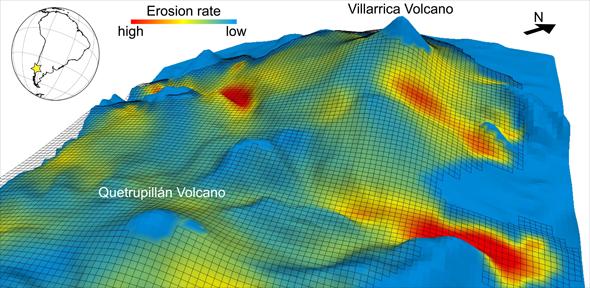Increase in volcanic eruptions at the end of the ice age caused by melting ice caps and erosion

This is a 3-D model simulation of a glaciation on the Villarrica Volcano (Chile). Credit: Pietro Sternai
“It's been established that melting ice caps and volcanic activity are linked – but what we've found is that erosion also plays a key role in the cycle,” said Dr Pietro Sternai of Cambridge's Department of Earth Sciences, the paper's lead author, who is also a member of Caltech's Division of Geological and Planetary Science.
“Previous attempts to model the huge increase in atmospheric CO2 at the end of the last ice age failed to account for the role of erosion, meaning that CO2 levels may have been seriously underestimated.”
Using numerical simulations, which modelled various different features such as ice caps and glacial erosion rates, Sternai and his colleagues from the University of Geneva and ETH Zurich found that erosion is just as important as melting ice in driving the increase in magma production and subsequent volcanic activity. The results are published in the journal Geophysical Research Letters.
Although the researchers caution not to draw too strong a link between anthropogenic (human-caused) climate change and increased volcanic activity as the timescales are very different, since we now live in a period where the ice caps are being melted by climate change, they say that the same mechanism will likely work at shorter timescales as well.
Over the past million years, the Earth has gone back and forth between ice ages, or glacial periods, and interglacial periods, with each period lasting for roughly 100,000 years. During the interglacial periods, such as the one we live in today, volcanic activity is much higher, as the lack of pressure provided by the ice caps means that volcanoes are freer to erupt. But in the transition from an ice age to an interglacial period, the rates of erosion also increase, especially in mountain ranges where volcanoes tend to cluster.
Glaciers are considered to be the most erosive force on Earth, and as they melt, the ground beneath is eroded by as much as ten centimetres per year, further decreasing the pressure on the volcano and increasing the likelihood of an eruption. A decrease in pressure enhances the production of magma at depth, since rocks held at lower pressure tend to melt at lower temperatures.
When volcanoes erupt, they release more carbon dioxide into the atmosphere, creating a cycle that speeds up the warming process. Previous models that attempted to explain the increase in atmospheric CO2 during the end of the last ice age accounted for the role of deglaciation in increasing volcanic activity, but did not account for erosion, meaning that CO2 levels may have been significantly underestimated.
A typical ice age lasting 100,000 years can be characterised into periods of advancing and retreating ice – the ice grows for 80,000 years, but it only takes 20,000 years for that ice to melt.
“There are several factors that contribute to climate warming and cooling trends, and many of them are related to the Earth's orbital parameters,” said Sternai. “But we know that much faster warming that cooling can't be caused solely by changes in the Earth's orbit – it must be, at least to some extent, related to something within the Earth system itself. Erosion, by contributing to unload the Earth's surface and enhance volcanic CO2 emissions, may be the missing factor required to explain such persistent climate asymmetry.”
Media Contact
All latest news from the category: Earth Sciences
Earth Sciences (also referred to as Geosciences), which deals with basic issues surrounding our planet, plays a vital role in the area of energy and raw materials supply.
Earth Sciences comprises subjects such as geology, geography, geological informatics, paleontology, mineralogy, petrography, crystallography, geophysics, geodesy, glaciology, cartography, photogrammetry, meteorology and seismology, early-warning systems, earthquake research and polar research.
Newest articles

High-energy-density aqueous battery based on halogen multi-electron transfer
Traditional non-aqueous lithium-ion batteries have a high energy density, but their safety is compromised due to the flammable organic electrolytes they utilize. Aqueous batteries use water as the solvent for…

First-ever combined heart pump and pig kidney transplant
…gives new hope to patient with terminal illness. Surgeons at NYU Langone Health performed the first-ever combined mechanical heart pump and gene-edited pig kidney transplant surgery in a 54-year-old woman…

Biophysics: Testing how well biomarkers work
LMU researchers have developed a method to determine how reliably target proteins can be labeled using super-resolution fluorescence microscopy. Modern microscopy techniques make it possible to examine the inner workings…





















